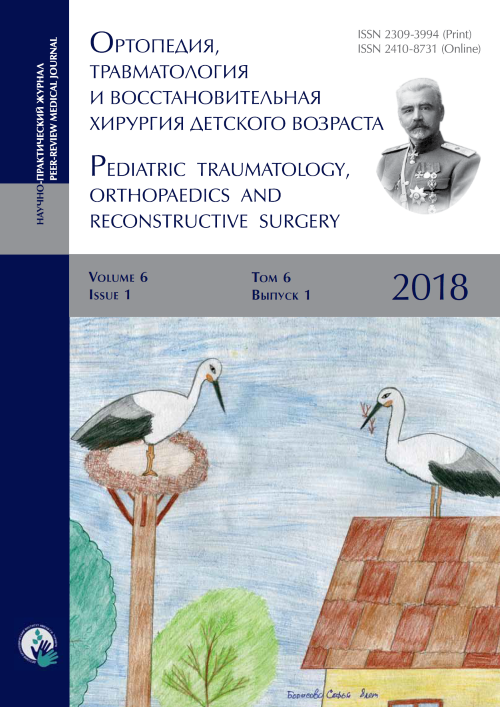Остеохондропатия венечного отростка локтевой кости у ребенка (случай из практики)
- Авторы: Никитин М.С.1, Прощенко Я.Н.1
-
Учреждения:
- ФГБУ «НИДОИ им. Г.И. Турнера» Минздрава России
- Выпуск: Том 6, № 1 (2018)
- Страницы: 55-57
- Раздел: Обмен опытом
- Статья получена: 26.03.2018
- Статья одобрена: 26.03.2018
- Статья опубликована: 26.03.2018
- URL: https://journals.eco-vector.com/turner/article/view/8391
- DOI: https://doi.org/10.17816/PTORS6155-57
- ID: 8391
Цитировать
Аннотация
Остеохондропатия проксимального отдела локтевой кости — редкое заболевание, которое поражает не только локтевой, но и венечный отросток. В отечественной и зарубежной медицинской литературе мы не нашли описания остеохондропатии венечного отростка у ребенка, вызывающей большой интерес с точки зрения диагностики и лечения. В статье представлен клинический случай остеохондропатии венечного отростка, описана клиническая картина поражения локтевого сустава у пациента, которая проиллюстрирована рентгенограммами, сделанными до и после хирургического лечения.
В описанном клиническом случае после хирургического лечения у ребенка прошли боли и восстановилась в полном объеме функция локтевого сустава, что позволяет нам расценить результат лечения как хороший и предположить, что выбранная активная хирургическая тактика лечения данного заболевания адекватна и своевременна.
Ключевые слова
Полный текст
Введение
Остеохондропатии — заболевания апофизов и эпифизов трубчатых костей и губчатого вещества коротких костей у детей, характеризующиеся медленно протекающими асептическими некрозами ядер окостенения, которые сопровождаются нарушением формы кости и ведут к деформации пораженного сегмента конечности с проявлениями нарушения функции вплоть до полной утраты [1].
В литературе выделяют четыре группы остеохондропатий: с поражением эпифизов длинных трубчатых костей; с поражением коротких губчатых костей; поражение апофизов и частичные остеохондропатии суставных поверхностей. По данным С.А. Рейнберга (1964), остеохондропатии любой локализации проходят пять стадий, которые следуют одна за другой, не разделяются строго по времени, причем возможно параллельное протекание двух и трех стадий, что говорит о некоторой условности рентгенологической стадийности процесса и многообразии клинических проявлений [1, 2].
Нужно отметить, что в литературе описано более 200 остеохондропатий различной локализации. Так, в начале прошлого столетия врачи Нильсон в 1921 г., Гасс в 1921 г. и Паннер в 1929 г. описали редкие остеохондропатии проксимального и дистального эпифиза плечевой кости, а в 1982 г. D. Capla и J. Kundrát представили случай остеохондропатии локтевого отростка у ребенка. В то же время описания поражения венечного отростка локтевой кости нет [3].
С учетом того что остеохондропатии могут быть различной локализации, был проведен поиск в отечественной и зарубежной литературе заболеваний асептического генеза венечного отростка у детей, тактики лечения и диагностики. Дополнительно с целью охвата большого количества описаний в зарубежной литературе по базе PubMed также был задан поиск на предмет остеохондропатии локтевой кости. Результат наших поисков оказался отрицательным, и мы не нашли описания или упоминания болезни (остеохондропатии) венечного отростка локтевой кости у детей.
Принимая во внимание, что поражение венечного отростка у детей само по себе редкое заболевание, мы решили представить клинический случай остеохондропатии венечного отростка у ребенка, что, на наш взгляд, является яркой демонстрацией нетипичной локализации этой болезни.
Клинический случай
Пациент А., 16 лет (2000 г. р.), профессионально занимается водным поло в течение 8 лет. С 2014 г. (в возрасте 14 лет) начали беспокоить боли в области локтевых суставов, документированных случаев травмы нет, за лечением не обращался. С 2016 г. интенсивность болевого синдрома в области левого локтевого сустава возросла, появились случаи отека левого локтевого сустава, ограничение разгибания в левом локтевом суставе. В связи с нарастанием симптомов пациент обратился в клинику НИДОИ им Г.И. Турнера. Он и его родители добровольно подписали информированное согласие на обработку персональных данных, обследование и выполнение хирургического вмешательства.
При осмотре отмечалась боль при пальпации медиальных отделов локтевых суставов, области венечного отростка, суставной щели (более выражено слева); наблюдалось ограничение разгибания в левом локтевом суставе до 170–175° (далее резкий болевой синдром). Сгибание и ротация не нарушены.
Проведены рентгенологическое и компьютерно-томографическое исследования (рис. 1–3), выявлен асептический некроз в области бугорка венечного отростка в стадии фрагментации.
Рис. 1. Рентгенограмма левого локтевого сустава. Стадия фрагментации области бугорка венечного отростка
Рис. 2. Компьютерная томография левого локтевого отростка, стадия фрагментации области бугорка вененчного отростка
Рис. 3. Компьютерная томография в режиме 3D
На основании проведенного обследования установлен диагноз: «Остеохондропатия венечного отростка левого локтевого сустава, контрактура, болевой синдром».
Учитывая, что ребенок занимается спортом и имеет выраженный болевой синдром, проведено хирургическое лечение — удаление фрагмента венечного отростка (рис. 4).
Рис. 4. Передне-задняя рентгенограмма левого локтевого сустава после операции
При осмотре через полгода пациент жалоб не предъявлял, объем движений в левом локтевом суставе полный, физические нагрузки безболезненные. Боковая стабильность локтевого сустава не нарушена.
Обсуждение
Диагностика остеохондропатии венечного отростка была основана на лучевых методах исследования, при проведении дифференциальной диагностики был исключен перелом, также нами была осуществлена диагностика на предмет аномалии развития — передняя локтевая кость, добавочное костное образование венечного отростка [1, 2, 4], что также не имело место.
Заключение
Представленный клинический случай остеохондропатии венечного отростка локтевой кости демонстрирует большое многообразие топических повреждений костей и непредсказуемость локализации асептического остеонекроза у детей.
Информация о финансировании и конфликте интересов
Работа проведена на базе и при поддержке ФГБУ «НИДОИ им. Г.И. Турнера» Минздрава России.
Авторы декларируют отсутствие явных и потенциальных конфликтов интересов, связанных с публикацией настоящей статьи.
Об авторах
Максим Сергеевич Никитин
ФГБУ «НИДОИ им. Г.И. Турнера» Минздрава России
Автор, ответственный за переписку.
Email: yar-2011@list.ru
травматолог-ортопед отделения последствий травм и ревматоидного артрита
Россия, 196603, г. Санкт-Петербург, г. Пушкин, ул. Парковая, дом 64-68Ярослав Николаевич Прощенко
ФГБУ «НИДОИ им. Г.И. Турнера» Минздрава России
Email: yar-2011@list.ru
канд. мед. наук, старший научный сотрудник отделения последствий травм и ревматоидного артрита
Россия, 196603, г. Санкт-Петербург, г. Пушкин, ул. Парковая, дом 64-68Список литературы
- Ортопедия: национальное руководство / Под ред. С.П. Пиронова, Г.П. Котельникова. – М.: ГЭОТАР-Медиа, 2013. [Pironov SP, Kotel’nikov GP, editors. Orthopedics: National guidelines. Moscow: GEOTAR-Media; 2013. (In Russ.)]
- Рейнберг С.А. Рентгенодиагностика заболеваний костей и суставов. – М.: Медицина, 1963. [Reynberg SA. X-ray diagnosis of diseases of bones and joints. Moscow: Meditsina; 1963. (In Russ.)]
- Capla D, Kundrat J. Necrosis apophyseos olecrani ulnae. Juvenile osteochondropathy of the ulna. Acta Chir Orthop Traumatol Cech. 1982;49(6):497-499.
- Королюк И.П. Рентгеноанатомический атлас. Cкелет (норма, варианты, ошибки интерпретации). – М.: Видар, 1996. [Korolyuk IP. X-ray anatomy atlas. Skeleton (norm, variants, interpretation errors). Moscow: Vidar; 1996. (In Russ.)]
Дополнительные файлы













